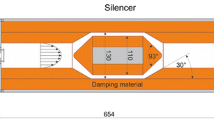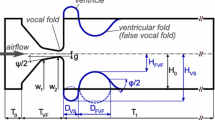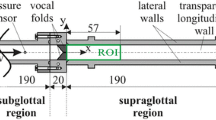Abstract
Flow through a driven, 7.5 times life-size vocal fold model was investigated at corresponding life-size flow rates of Q mean = 89.1 ml/s, 159.4 ml/s, and 253.0 ml/s. The flow was scaled to match physiological values for Reynolds, Strouhal, and Euler numbers. The models were driven at a life-size frequency of 94 Hz. Particle image velocimetry (PIV) data were acquired in the anterior–posterior midplane of the glottis, and the unsteady transglottal pressure drop across the vocal folds was simultaneously measured. Flow and pressure data were obtained at four discrete instances during the closing phases of the phonatory cycle for which t/T open = 0.60, 0.70, 0.80, and 0.90. The glottal jet trajectory exhibited a bimodal distribution of flow attachment between the two medial surfaces of the glottis. Vortex shedding at the trailing edge separation point generated instabilities in the shear layer, which caused large oscillations in the glottal jet orientation downstream of the glottal exit. The development of the Coanda effect during the glottal cycle was found to have minimal impact on the transglottal pressure drop, suggesting that flow orientation does not directly influence the dipole sound source. The change in transglottal pressure drop as a result of jet trajectory was less than 2% for all three investigated flow rates.












Similar content being viewed by others
References
Alipour F, Scherer RC (1995) Pulsatile airflow during phonation: an excised larynx model. J Acoust Soc Am 97:1241–1248
Alipour F, Patel VC, Scherer RC (1995a) Measurement of pulsatile flow in excised larynges with hot-wire anemometry. ASME FED Indl Papers in Fluids Eng 202:1–5
Alipour F, Patel VC, Scherer RC (1995b) An experimental study of pulsatile flow in canine larynges. J Fluids Eng 117:577–581
Becker S, Kniesburges S, Muller S, Delgado A, Link G, Kaltenbacher M, Dollinger M (2009) Flow-structure-acoustic interaction in a human voice model. J Acoust Soc Am 125(3):1351–1361
Coanda H (1936) Device for deflecting a stream of elastic fluid projected into an elastic fluid. U.S. Patent No 2,052,869 Sept. 1, 1936
Dreschsel JS, Thomson SL (2008) Influence of supraglottal structures on the glottal jet exiting a two-layer synthetic, self-oscillating vocal fold model. J Acoust Soc Am 123(6):4434–4445
Erath BD (2005) An experimental investigation of velocity fields in divergent glottal models of the human vocal tract. M.S. Thesis, Purdue University
Erath BD, Plesniak MW (2006a) The occurrence of the Coanda effect in pulsatile flow through static models of the human vocal folds. J Acoust Soc Am 120(2):1000–1011. doi:10.1121/1.2213522
Erath BD, Plesniak MW (2006b) An investigation of bimodal jet trajectory in flow through scaled models of the human vocal tract. Exp Fluids 40:683–696
Erath BD, Plesniak MW (2006c) An investigation of jet trajectory in flow through scaled vocal fold models with asymmetrical glottal passages. Exp Fluids 41:735–748
Ffowcs-Williams J, Hawkings D (1969) Sound generated by turbulence and surfaces in arbitrary motion. Philos Trans R Soc Lond A 264(1151):321–342
Flanagan JL (1958) Some properties of the glottal sound source. J Speech Hear Res 1(2):99–116
Fox RW, Kline SJ (1962) Flow regime data and design methods for curved subsonic diffusers. J Basic Eng Trans ASME 84:303–312
Fox RW, McDonald AT, Pritchard PJ (2004) Introduction to fluid mechanics, 6th edn. Wiley, New York
Gauffin J, Liljencrants J (1988) The role of convective acceleration in glottal aerodynamics. In: Fujimura O (ed) Vocal physiology: voice production, mechanisms and functions. Raven Press, New York
Ghose S, Kline SJ (1978) The computation of optimum pressure recovery in two-dimensional diffusers. J Fluids Eng 100:419–426
Hirschberg A, Pelorson X, Hofmans GCJ, van Hassel RR, Wijnands APJ (1996) Starting transient of the flow through an in-vitro model of the vocal folds. In: Davis PJ, Fletcher NH (eds) Vocal fold physiology: controlling complexity and chaos. Singular Publishing Group, San Diego, pp 31–46
Hofmans GCJ, Groot G, Ranucci M, Graziani G, Hirschberg A (2003) Unsteady flow through in-vitro models of the glottis. J Acoust Soc Am 113:1658–1675
Holmberg EB, Hillman RE, Perkell JS (1988) Glottal airflow and transglottal air pressure measurements for male and female speakers in soft, normal, and loud voice. J Acoust Soc Am 4(2):511–529
Ishizaka K, Matsudaira M (1972) Fluid mechanical considerations of vocal fold vibration. SCRL (Speech Communications Research Laboratory), Monograph No. 8, Santa Barbara, CA
Kaiser JF (1983) Some observations on vocal tract operation from a fluid flow point of view. In: Titze IR, Scherer RC (eds) Vocal fold physiology: biomechanics, acoustics, and phonatory control. Denver center for the performing arts, Denver, pp 358–386
Khosla S, Muruguppan S, Gutmark E, Scherer R (2007) Vortical flow field during phonation in an excised canine larynx model. Ann Otol Rhinol Laryngol 116(3):217–228
Kline SJ (1959) On the nature of stall. J Basic Eng 81:305–320
Krane MH, Barry M, Wei T (2007) Unsteady behavior of flow in a scaled–up vocal folds model. J Acoust Soc Am 122(6):3659–3670
Kwong AHM, Dowling AP (1994) Unsteady flow in diffusers. J Fluid Eng 116:842–847
Morel T (1977) Design of two-dimensional wind tunnel contractions. J Fluid Eng 99:371–378
Neubauer J, Zhang Z, Miraghie R, Berry D (2007) Coherent structures of the near field flow in a self-oscillating physical model of the vocal folds. J Acoust Soc Am 121(2):1102–1118
Pelorson X, Hirschberg A, van Hassel RR, Wijnands APJ (1994) Theoretical and experimental study of quasisteady-flow separation within the glottis during phonation. Application to a modified two-mass model. J Acoust Soc Am 96:3416–3431
Pelorson X, Hirschberg A, Wijnands APJ, Bailliet HMA (1995) Description of the flow through in-vitro models of the glottis during phonation. Acta Acustica 3:191–202
Pelorson X, Vescovi C, Castelli E, Hirschberg A, Wijnands APJ, Bailliet HMA (1996) Description of the flow through in-vitro models of the glottis during phonation: application to voiced sound synthesis. Acta Acustica 82:358–361
Scherer RC, Titze IR (1983) Pressure-flow relationships in a model of the laryngeal airway with a diverging glottis. In: Bless DM, Abbs JH (eds) Vocal fold physiology: contemporary research and clinical issues. College-Hill, San Diego, pp 179–193
Scherer RC, Titze IR, Curtis JF (1983) Pressure-flow relationships in two models of the larynx having rectangular glottal shapes. J Acoust Soc Am 73:668–676
Scherer RC, Shinwari D, DeWitt KJ, Zhang C, Kucinschi BR, Afjeh AA (2001) Intraglottal pressure profiles for a symmetric and oblique glottis with a divergence angle of 10 degrees. J Acoust Soc Am 109:1616–1630
Shinwari D, Scherer RC, DeWitt K, Abdollah AA (2003) Flow visualization and pressure distributions in a model of the glottis with a symmetric and oblique divergent angle of 10 degrees. J Acoust Soc Am 113:487–497
Smith CR, Kline SJ (1974) An experimental investigation of the transitory stall regime in two-dimensional diffusers. J Fluids Eng 96:11–15
Stevens KN (2000) Acoustic phonetics. The MIT press, Boston
Teager HM, Teager SM (1980) The effects of separated air flow on vocalization. In: Bless DM, Abbs JH (eds) Vocal fold physiology: contemporary research and clinical issues. College-Hill, San Diego, pp 124–143
Teager HM, Teager SM (1983) Active fluid dynamic voice production models, or there is a unicorn in the garden. In: Titze IR, Scherer RC (eds) Vocal fold physiology: biomechanics, acoustics, and phonatory control. Denver center for the performing arts, Denver, pp 387–401
Thomson SL (2004) Fluid–structure interactions within the human larynx. Ph.D. Dissertation, Purdue University
Thomson SL, Mongeau L, Frankel SH (2005) Aerodynamic transfer of energy to the vocal folds. J Acoust Soc Am 118(3):1689–1700
Triep M, Ch Brucker, Schroder W (2005) High-speed PIV measurements of the flow downstream of a dynamic mechanical model of the human vocal folds. Exp Fluids 39:232–245
van den Berg JW, Zantema JT, Doornenbal P Jr (1957) On the air resistance and the Bernoulli effect of the human larynx. J Acoust Soc Am 29:626–631
Wegel RL (1930) Theory of vibration of the larynx. J Acoust Soc Am 1:1–21
Zhang Z, Mongeau L, Frankel SH (2002) Experimental verification of the quasisteady approximation for aerodynamic sound generation by pulsating jets in tubes. J Acoust Soc Am 112:1652–1663
Zhao W, Frankel SH, Mongeua L (2001) Numerical simulations of sound from confined pulsating axisymmetric jets. AIAA J 39(10):1868–1874
Zhao W, Zhang C, Frankel SH, Mongeau L (2002) Computational aeroacoustics of phonation, Part I: Computational methods and sound generation mechanisms. J Acoust Soc Am 112(5):2134–2146
Acknowledgments
This research was supported by grant CBET-0828903 from the Division of Chemical, Bioengineering, Environmental, and Transport Systems (CBET), National Science Foundation.
Author information
Authors and Affiliations
Corresponding author
Rights and permissions
About this article
Cite this article
Erath, B.D., Plesniak, M.W. An investigation of asymmetric flow features in a scaled-up driven model of the human vocal folds. Exp Fluids 49, 131–146 (2010). https://doi.org/10.1007/s00348-009-0809-0
Received:
Revised:
Accepted:
Published:
Issue Date:
DOI: https://doi.org/10.1007/s00348-009-0809-0




